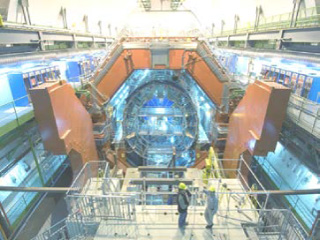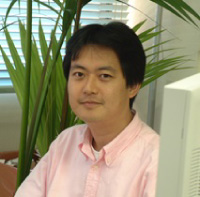This group aims at revealing the ultimate structure of a new state of matter referred to as quark-gluon plasma (QGP). This high-temperature quark matter can be created in high-energy nucleus-nucleus collisions at the world’s leading particle accelerators, and was present in the very early Universe just after the Big Bang. The mechanism of quark (de-)confinement and the origin of mass are yet to be understood. There is also no complete scenario describing the birth of the Universe.
[Group Members] [Quark Physics Group Web Site]
Search for Quark Gluon Plasma
The hot dense Universe immediately after the Big Bang was filled with QGP, a completely different state of matter from that which exists now, for a few millionths of a second. We have been performing world-leading research to investigate quark matter, in collaboration with international researchers. In 2000, after a long period of search, we found an unknown state of matter, known as QGP, during high-energy collisions of gold nuclei in the PHENIX experiment at the Relativistic Heavy Ion Collider (RHIC), the first ever nucleus collider, in New York, USA. This quark matter behaves like a perfect fluid, which is unpredicted by any theory. We are now conducting experiments using the ALICE detector at the next-generation LHC accelerator at CERN, in an attempt to reveal the nature of this new state of quark matter.
The ALICE Experiment at CERN-LHC

View of the ALICE cavern, Photograph: Mona Schweizer © 2007 CERN
CERN is the world’s leading laboratory for particle and nuclear physics, and is located in Geneva, Switzerland. The LHC accelerator is the largest nuclear collider, with a circumference of 27 km. It is located on the Swiss-French border, and achieves 28 times more collision energy than the RHIC. About 1,200 researchers from more than 30 countries are involved in the ALICE experiment, with the goal of forming a comprehensive understanding of quark matter utilizing this cutting-edge particle accelerator.
Quark Physics and the Universe
The Universe started as a hot fireball at the Big Bang, and then rapidly cooled while expanding, to reach a state filled with light nuclei such as helium together with electrons during the initial few minutes. In the first few millionths of a second, elementary quarks became confined in hadrons such as protons and neutrons, and have never been released in the 13.8 billion years that have elapsed since then. We use high-energy nuclear collisions to look upstream of this period toward the Big Bang itself, recreating the state of matter which filled the very early Universe, to reveal the nature of the hot dense quark matter, and to form a complete scenario for the creation of the Universe.
Group Members

Kenta Shigaki (Professor)
If you would like to know about zebras, the best approach is not simply to observe them in the savanna; you should also breed them by yourself. The same is also true for the Universe.
I am conducting high-energy nuclear physics experiments, referred to as ALICE and PHENIX, to investigate the high-temperature state of the matter that filled the Universe immediately after the Big Bang. My particular interests include spontaneous breaking of chiral symmetry, the origin of the “mass” of matter, and the restoration of symmetry in hot quark matter, which are associated with the period in the very early universe when quarks were not confined within hadrons such as protons. I am also interested in detection of the most intense magnetic field in the universe, created in high-energy nuclear collisions, and exotic phenomena that occur in such fields, such as non-linear quantum electrodynamics.

Kensuke Homma (Associate Professor)
In the frontiers of particle physics and cosmology, the vacuum state is not considered to be empty, but to be the origin of all matter. In the early Universe, a high-temperature state existed. As the Universe expanded and cooled, the elementary forces were split into the forms that we now see. Among these forces, the phase transition relevant to the strong force forming nucleus takes place and visible matter like protons and neutrons are materialized. This can be interpreted as a kind of phase transition of the vacuum state in the early Universe, and its study is one of my interests. After further cooling of the Universe, the state that we currently refer to as a vacuum was formed. However, based on the results of many types of astronomical observations, the present vacuum state appears to be made up of invisible entities known as dark matter and dark energy. In the everyday world, dark objects can be visualized by shining a bright light on them, and observing reflection or scattering. Similarly, if we illuminate the vacuum with highly intense light, the nature of dark entities within it may become apparent due to scattering. This can be verified using extremely intense laser light. Based on this approach, I am performing a search for dark matter and dark energy.

Takahiro Miyoshi (Assistant Professor)
Theoretical and computational researches in plasma physics are being promoted. My recent work has focused mainly on research and development of advanced numerical methods for plasma fluid equations. Interactions between electromagnetic fields and plasma flows play important roles in many dynamic phenomena related to space and astrophysics. Advanced numerical methods allow us to model such complicated interactions, and to reveal unknown plasma processes. In particular, our original numerical solver, the so-called HLLD approximate Riemann solver, for magnetohydrodynamics is widely used by the plasma astrophysics community, and has almost become the standard solver. I will continue to study unexplored plasma dynamics in extreme parameter regions using powerful state-of-the-art numerical methods.
